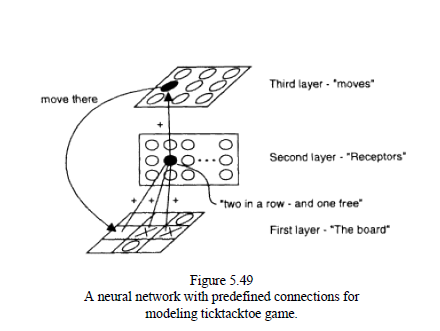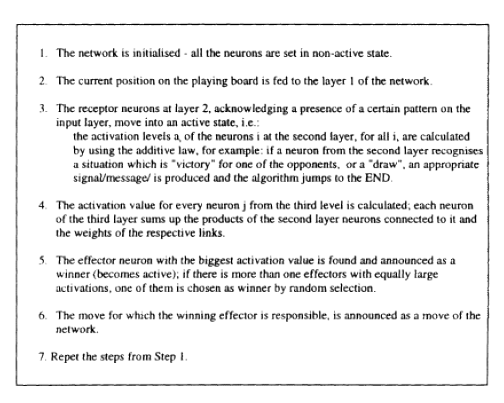Hierarchical Multimodular Network Architectures For Playing Games
Introduction: -This approach is based on building different layers of neural networks that perform different consecutivetasks in the process of finding the best next move. For example, layer 1, an input layer, receives datafrom the board; layer 2, an intermediate layer of receptor neurons, recognizes patterns, features, and situations on the game board; and layer 3, an output layer of effector neurons, selects the best next move.
 The patterns on the board are detected, and appropriate neurons in the intermediate layer are activated accordingly. This requires prewired connections. The weights are preset and no training is required. A connectionist model of this type was presented in Rumelhart et al. (1986a). Having established the links between the neurons from different layers in the network, the system will "play," performing the algorithm.
The patterns on the board are detected, and appropriate neurons in the intermediate layer are activated accordingly. This requires prewired connections. The weights are preset and no training is required. A connectionist model of this type was presented in Rumelhart et al. (1986a). Having established the links between the neurons from different layers in the network, the system will "play," performing the algorithm.
The representation of game strategies in the suggested connectionist model is carried into effect in the following way. The operator, creating or perfecting the network, defines the most important configurations (characteristics) generated in the game process. The presence or absence of one such characteristic determines the need for performing, or refraining from performing, certain moves. For every major characteristic of the game a neural element is constructed in the second layer of the network, sensitive to the appearance (or absence) of the respective configuration characteristic on the game board.
If we consider that the appearance of a certain configuration on the board implies a responsive move, we have to connect the neuron from the second layer corresponding to this configuration to the effector from the third layer corresponding to the move, with a positive link. If it is required that the absence of a certain characteristic implies a certain move (or moves), a neuron is introduced at the second layer which is activated by the absence of that characteristic and is similarly connected to the respective effectors with positive links. When certain moves becomeundesirable owing to the presence or absence of a certain configuration, their corresponding effector elements are connected to the neuron responsible for detecting this particular configuration, with a negative link.
